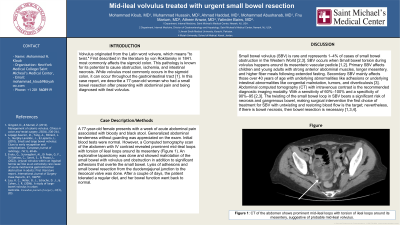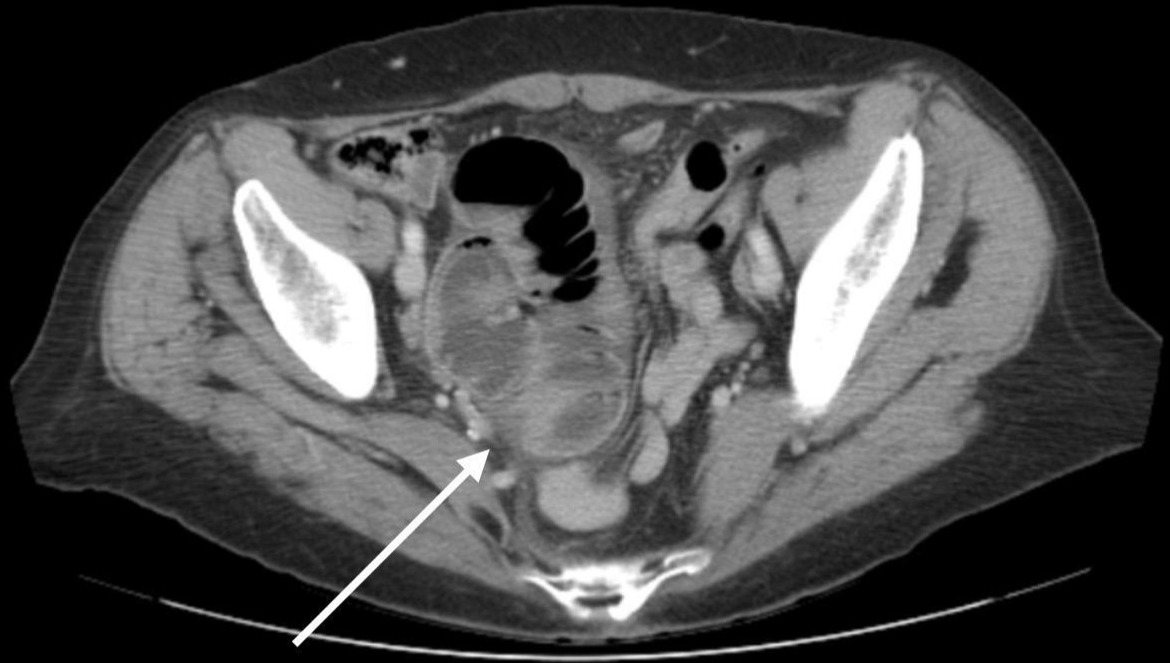Tuesday Poster Session
Category: Small Intestine
P4990 - Mid-Ileal Volvulus Treated With Urgent Small Bowel Resection
Tuesday, October 29, 2024
10:30 AM - 4:00 PM ET
Location: Exhibit Hall E

Has Audio

Mohammad N. Kloub, MD
New York Medical College - Saint Michael's Medical Center
Newark, NJ
Presenting Author(s)
Mohammad N. Kloub, MD1, Muhammad Hussain, MD1, Ahmad Haddad, MD1, Mohammad Abushanab, MD1, Fnu Marium, MD2, Atheer Anwar, MD3, Yatinder Bains, MD1
1New York Medical College - Saint Michael's Medical Center, Newark, NJ; 2Jinnah Sindh Medical University, Newark, NJ; 3Mutah University, Newark, NJ
Introduction: Volvulus originated from the Latin word volvere, which means "to twist." First described in the literature by von Rokitansky in 1841. most commonly affects the sigmoid colon. This pathology is known for its potential to cause obstruction, ischemia, and intestinal necrosis. While volvulus most commonly occurs in the sigmoid colon, it can occur throughout the gastrointestinal tract [1]. In this case report, we describe a 77-year-old woman who had a small bowel resection after presenting with abdominal pain and being diagnosed with ileal volvulus.
Case Description/Methods: A 77-year-old female presents with a week of acute abdominal pain associated with bloody and black stool. Generalized abdominal tenderness without guarding was appreciated on the exam. Initial blood tests were normal. However, a Computed tomography scan of the abdomen with IV contrast revealed prominent mid-ileal loops with torsion of ileal loops around its mesentery. An explorative laparotomy was done and showed malrotation of the small bowel with volvulus and obstruction in addition to significant adhesions that overlie the small bowel. Lysis of adhesions and small bowel resection from the duodenojejunal junction to the ileocecal valve was done. After a couple of days, the patient tolerated a regular diet, and her bowel function went back to normal.
Discussion: Small bowel volvulus (SBV) is rare and represents 1–4% of cases of small bowel obstruction in the Western World [2,3]. SBV occurs when Small bowel torsion during volvulus happens around its mesenteric vascular pedicle [1,2]. Primary SBV affects children and young adults with strong anterior abdominal muscles, longer mesentery, and higher fiber meals following extended fasting. Secondary SBV mainly affects those over 40 years of age with underlying abnormalities like adhesions or underlying intestinal abnormalities like congenital malrotation, tumors, and diverticulosis [3]. Abdominal computed tomography (CT) with intravenous contrast is the recommended diagnostic imaging modality. With a sensitivity of 60%–100% and a specificity of 90%–95 [2,3]. The twisting of the small bowel loop in SBV bears a significant risk of necrosis and gangrenous bowel, making surgical intervention the first choice of treatment for SBV with untwisting and restoring blood flow is the target; nevertheless, if there is bowel necrosis, then bowel resection is necessary [1,3,4].

Disclosures:
Mohammad N. Kloub, MD1, Muhammad Hussain, MD1, Ahmad Haddad, MD1, Mohammad Abushanab, MD1, Fnu Marium, MD2, Atheer Anwar, MD3, Yatinder Bains, MD1. P4990 - Mid-Ileal Volvulus Treated With Urgent Small Bowel Resection, ACG 2024 Annual Scientific Meeting Abstracts. Philadelphia, PA: American College of Gastroenterology.
1New York Medical College - Saint Michael's Medical Center, Newark, NJ; 2Jinnah Sindh Medical University, Newark, NJ; 3Mutah University, Newark, NJ
Introduction: Volvulus originated from the Latin word volvere, which means "to twist." First described in the literature by von Rokitansky in 1841. most commonly affects the sigmoid colon. This pathology is known for its potential to cause obstruction, ischemia, and intestinal necrosis. While volvulus most commonly occurs in the sigmoid colon, it can occur throughout the gastrointestinal tract [1]. In this case report, we describe a 77-year-old woman who had a small bowel resection after presenting with abdominal pain and being diagnosed with ileal volvulus.
Case Description/Methods: A 77-year-old female presents with a week of acute abdominal pain associated with bloody and black stool. Generalized abdominal tenderness without guarding was appreciated on the exam. Initial blood tests were normal. However, a Computed tomography scan of the abdomen with IV contrast revealed prominent mid-ileal loops with torsion of ileal loops around its mesentery. An explorative laparotomy was done and showed malrotation of the small bowel with volvulus and obstruction in addition to significant adhesions that overlie the small bowel. Lysis of adhesions and small bowel resection from the duodenojejunal junction to the ileocecal valve was done. After a couple of days, the patient tolerated a regular diet, and her bowel function went back to normal.
Discussion: Small bowel volvulus (SBV) is rare and represents 1–4% of cases of small bowel obstruction in the Western World [2,3]. SBV occurs when Small bowel torsion during volvulus happens around its mesenteric vascular pedicle [1,2]. Primary SBV affects children and young adults with strong anterior abdominal muscles, longer mesentery, and higher fiber meals following extended fasting. Secondary SBV mainly affects those over 40 years of age with underlying abnormalities like adhesions or underlying intestinal abnormalities like congenital malrotation, tumors, and diverticulosis [3]. Abdominal computed tomography (CT) with intravenous contrast is the recommended diagnostic imaging modality. With a sensitivity of 60%–100% and a specificity of 90%–95 [2,3]. The twisting of the small bowel loop in SBV bears a significant risk of necrosis and gangrenous bowel, making surgical intervention the first choice of treatment for SBV with untwisting and restoring blood flow is the target; nevertheless, if there is bowel necrosis, then bowel resection is necessary [1,3,4].

Figure: CT abdomen shows prominent mid-ileal loops with torsion of ileal loops around its mesentery, suggestive of probable mid-ileal volvulus.
Disclosures:
Mohammad Kloub indicated no relevant financial relationships.
Muhammad Hussain indicated no relevant financial relationships.
Ahmad Haddad indicated no relevant financial relationships.
Mohammad Abushanab indicated no relevant financial relationships.
Fnu Marium indicated no relevant financial relationships.
Atheer Anwar indicated no relevant financial relationships.
Yatinder Bains indicated no relevant financial relationships.
Mohammad N. Kloub, MD1, Muhammad Hussain, MD1, Ahmad Haddad, MD1, Mohammad Abushanab, MD1, Fnu Marium, MD2, Atheer Anwar, MD3, Yatinder Bains, MD1. P4990 - Mid-Ileal Volvulus Treated With Urgent Small Bowel Resection, ACG 2024 Annual Scientific Meeting Abstracts. Philadelphia, PA: American College of Gastroenterology.
